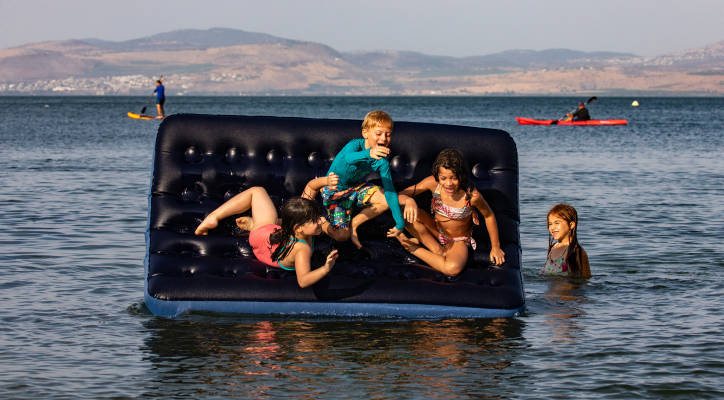“I invite everyone to come this weekend, to enjoy our great beaches, the [view of] the snow-capped Golan and the most beautiful area in Israel,” said the ecstatic chairman of the Kinneret Cities Association, following a wonderful rainy season.
By Yakir Benzion, United With Israel
After years of drought, the successful rainy season so far this year coupled with recent blizzards in the north has put the world-famous Sea of Galilee, known in Hebrew as Lake Kinneret, on the way to its highest level in decades, the Kinneret Cities Association reported Thursday.
There are only 52 centimeters (20 inches) needed for the sea to reach its maximum level, in which case the communities on its shores, including the city of Tiberias, would be flooded.
But before that happens, floodgates located near Kibbutz Degania and the mouth of the Jordan River will be opened, allowing the excess waters to flow down the Jordan Valley towards the Dead Sea.
The last time those gates were opened was in 1992, and with more rain in the forecast, the Kinneret Cities Association that monitors the water levels is expected to make the decision in the coming weeks to open the gates before the flood level is reached.
An excited Idan Greenbaum, Chairman of the Kinneret Cities Association and head of the Jordan Valley Regional Council, called on Israelis to come to the area and be thrilled by the sight of a full Kinneret, especially with the forecast for the weekend being sunny skies and a high of 22 degrees (72 Fahrenheit).
“Over the past weeks we’ve seen a tremendous flow in all the rivers leading into the Kinneret,” Greenbaum said in a video on Facebook. “I invite everyone to come this weekend … to enjoy our great beaches, the [view of] the snow-capped Golan and the most beautiful area in Israel.”
The lake is now 5.5 meters (18 feet) higher than its most recent lowest level recorded in 2001. Even without rain, melting snow from the Hermon mountains on the Golan Heights above the lake will continue for months to feed streams that flow into the lake.
Lack of rain over the past three decades helped lower the lake to dangerous levels where experts feared irreversible damage could be done to the Kinneret and the surrounding ecosystems. At one point, the water level had gotten so low that an island appeared.
Surprising to many, Lake Kinneret itself is way below sea level, with the annual Tiberias marathon being the world’s lowest at 200 meters (660 feet) below sea level.
For many years, the Sea of Galilee provided much of Israel’s drinking and irrigation water, but as the population soared and demand increased, the country installed several water desalination plants on the Mediterranean coast. Waste water is now recycled for agriculture, contributing to lowering the demand on the stressed lake.
The Sea of Galilee’s long-term drought conditions have also wreaked havoc, as the Jordan River that flows south from the lake also feeds the Dead Sea, the lowest point on the planet at 430.5 meters (1,412 ft) below sea level.
With waters from the Galilee and Jordan River diverted by both Israeli and Jordanian farmers, the Dead Sea basin has been steadily drained. Hundreds of massive sink holes have rendered parts of the area too dangerous to be visited.
Should the rains continue and the floodgates open, that extra water will help replenish the parched Dead Sea area.
